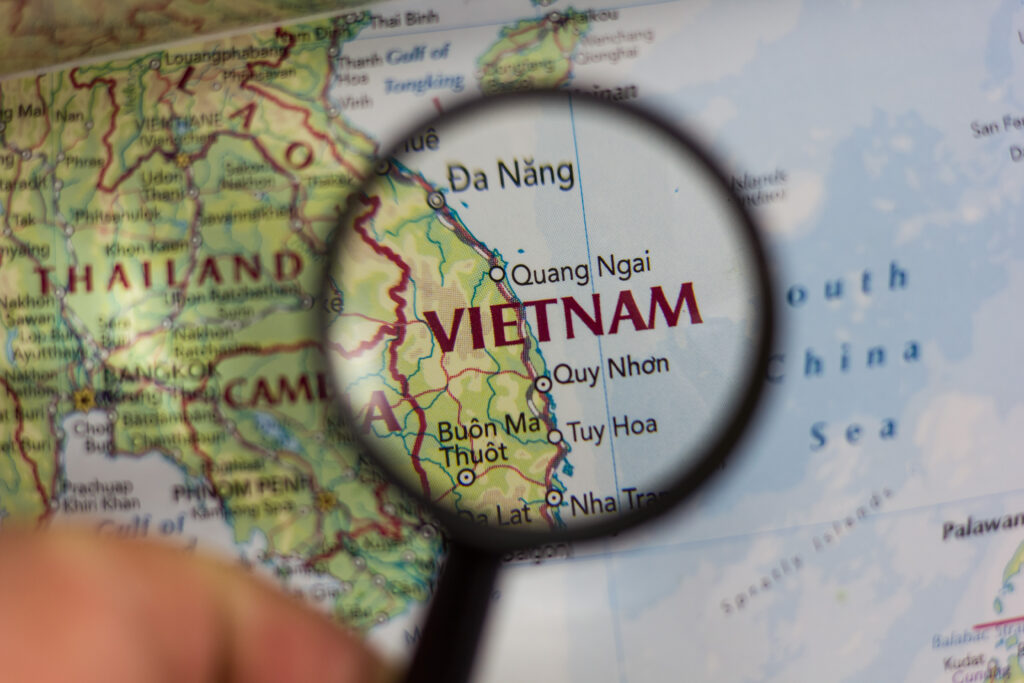Discovering the Heart of Vietnam
Cycling in Vietnam
The Geography
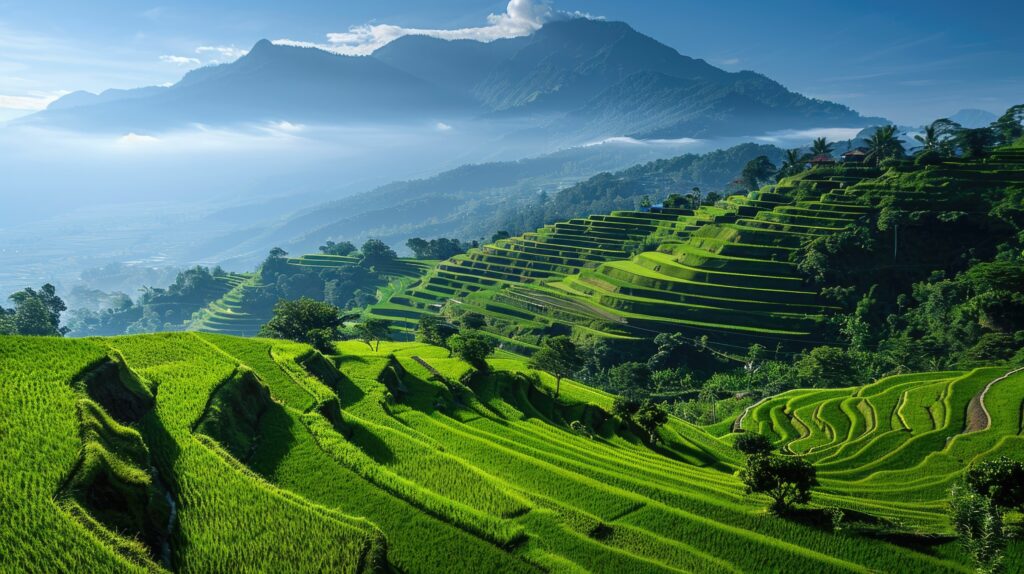
Welcome to Vietnam, my beautiful homeland in Southeast Asia! Our country is a tropical gem, stretching between the latitudes 8° and 24° N, with a shape that reminds me of a graceful, curving scythe. At its narrowest point, Vietnam looks so slender, but it widens out beautifully at both ends. We have a long, stunning coastline running along the South China Sea—part of the great Pacific Ocean. When you explore our country, you’ll notice how hilly it is, with mountains covering over 40% of the land. And don’t forget our lush tropical rainforests, which cover almost half of Vietnam.
- Northern Vietnam — In the north, you’ll find the stunning Red River Delta, a flat and fertile region known for its endless green rice paddies. This area is often referred to as the “rice bowl” of Vietnam, where agriculture thrives. In addition to the delta, northern Vietnam is home to the towering peaks of the Hoang Lien Son Mountain Range and the karst landscapes that define regions like Ninh Binh.
- Central Vietnam — Central Vietnam is known for its rugged mountains, ancient cities, and serene coastline. The Annamite Range separates the country from Laos and features dense forests, perfect for those looking for a wilder adventure. Coastal towns like Hue and Hoi An offer a balance between history and natural beauty.
- Southern Vietnam — In the south, you’ll discover the famous Mekong Delta, where rivers, canals, and lush landscapes create a serene environment. Southern Vietnam is flatter than the north, making it perfect for easy cycling, especially through the quiet countryside and bustling floating markets.
Each of these diverse regions has something unique to offer, and cycling allows you to experience these places up close, making your adventure personal and unforgettable.
Incredible Wildlife and Vegetation
Vietnam is like a treasure chest of biodiversity, filled with 16% of the world’s species! Our forests are home to unique creatures like the elusive clouded leopard, the adorable douc langurs, and even the critically endangered Javan rhinoceros. Along our coastlines, you’ll find vibrant marine life, and our wetlands are bustling with beautiful bird species such as the Sarus Crane. In the mountainous regions of northern Vietnam, you might come across rare species like the Tonkin snub-nosed monkey.
The best places to experience Vietnam’s wildlife are in national parks like Cuc Phuong, Nam Cat Tien, and Phong Nha-Ke Bang, where guided eco-tours allow you to appreciate our rich natural world.
The Climate
Vietnam’s warm, tropical climate is just like its people—full of life! We have plenty of rain, which keeps our forests and rice fields lush and green. Because we’re so close to the sea and blessed with mountains, the weather stays pleasant throughout the year. Northern Vietnam experiences cooler winters, while the south remains warm year-round. Each region has its own unique charm, no matter when you visit, so you can plan your trip accordingly based on the climate.
Hint: Checking out “Best time to visit Vietnam” article will help you decide the best time to visit Vietnam based on your preferences.
Our Growing Economy
Vietnam is not just a country of natural beauty; it’s also home to nearly 100 million people who work hard and enjoy life. Agriculture has always been at the heart of our economy, but we’ve grown in other areas like petroleum, tourism, and the services industry. Our country has been developing quickly, and we’re proud to be one of the fastest-growing economies in the world. Vietnam is a regional leader in Southeast Asia and plays a strong role in the international community.
Exploring Vietnam by Bicycle: A Unique Experience
Cycling in Vietnam

Cycling through Vietnam is more than just a journey through picturesque landscapes. It’s about immersing yourself in the culture, meeting locals in their villages, and feeling the rhythm of life as you ride. Whether you’re coasting along the peaceful Mekong Delta or navigating the bustling streets of Hanoi, being on a bicycle offers a close-up experience like no other. You can stop anywhere, anytime, to take a photo, grab a snack, or have a quick chat with a farmer working in the fields.
Biking through Vietnam allows you to connect with places and people at a slower, more intentional pace. It’s an adventure that lets you embrace the country’s rich history and natural beauty while having the flexibility to wander off the beaten path.
Why Should You Cycle Through Vietnam?
Cycling in Vietnam
Cycling in Vietnam is a truly special experience, blending our breathtaking landscapes, rich cultural heritage, and the warm spirit of our people. Whether you’re a cycling enthusiast or just looking for a unique way to explore, Vietnam has so much to offer. Here are five great reasons to hop on a bike and see the country from a new perspective:
Diverse Natural Beauty

Vietnam’s landscapes are full of surprises. Imagine pedaling through the green paddy fields of the Mekong Delta, climbing misty mountains in Sapa, or cruising along our serene beaches. Each region has its own unique scenery, from the peaceful beaches of Central Vietnam to the majestic limestone karsts in the north. Cycling lets you experience it all up close.
In the Mekong Delta, you’ll ride past lush orchards, floating markets, and traditional stilt houses.
In the highlands of central and northern Vietnam, you’ll encounter terraced rice fields carved into the hillsides.
Terraced Rice Fields and Karst Mountains
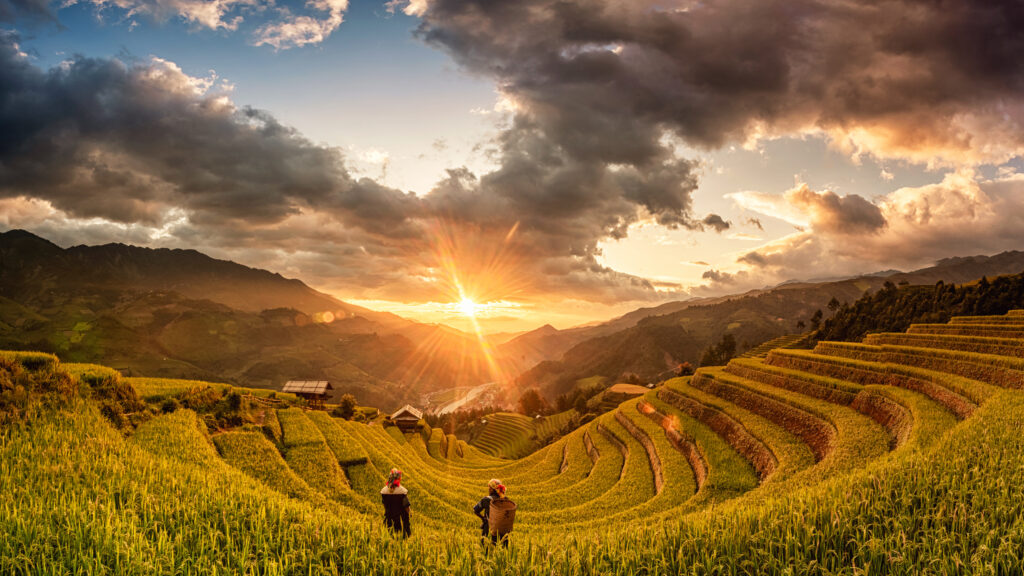
Northern Vietnam is famous for its stunning terraced rice fields, especially in places like Sapa, Ninh Binh, and Mai Chau. The dramatic karst mountains are unforgettable, towering over the landscape like ancient guardians. Cycling through these regions is a workout for the body and a treat for the eyes, immersing you in some of Vietnam’s most iconic views.
Rich Cultural Traditions
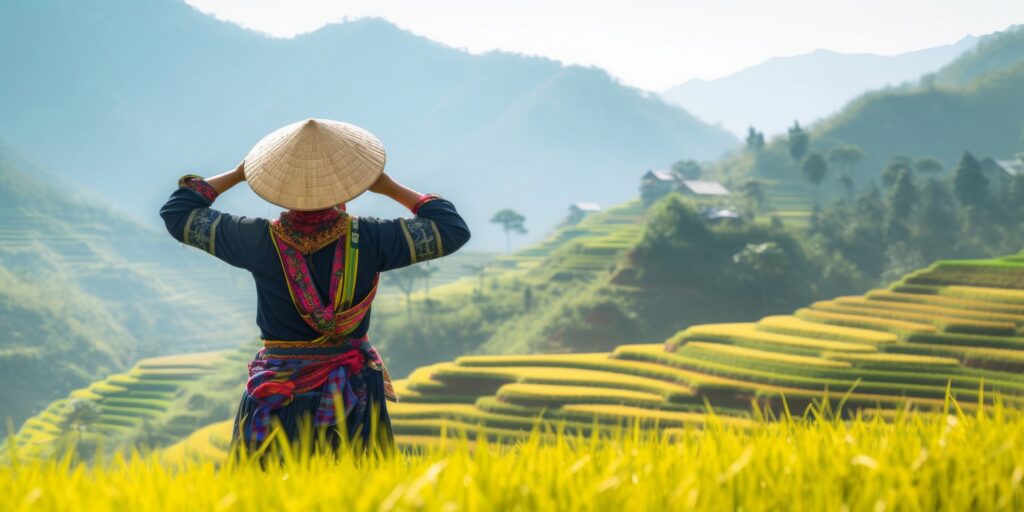
Vietnam’s cultural diversity is one of its greatest treasures. With 54 ethnic groups, each with its own customs and traditions, cycling through rural areas gives you a front-row seat to authentic Vietnamese life. You’ll see how we live, work, and celebrate. It’s always a rewarding experience to connect with locals—you’ll be greeted with smiles and friendly conversations.
In northern areas like Sapa and Ha Giang, you’ll encounter ethnic minorities like the Hmong and Tay people, with their distinctive clothing and traditions.
Delicious Vietnamese Food
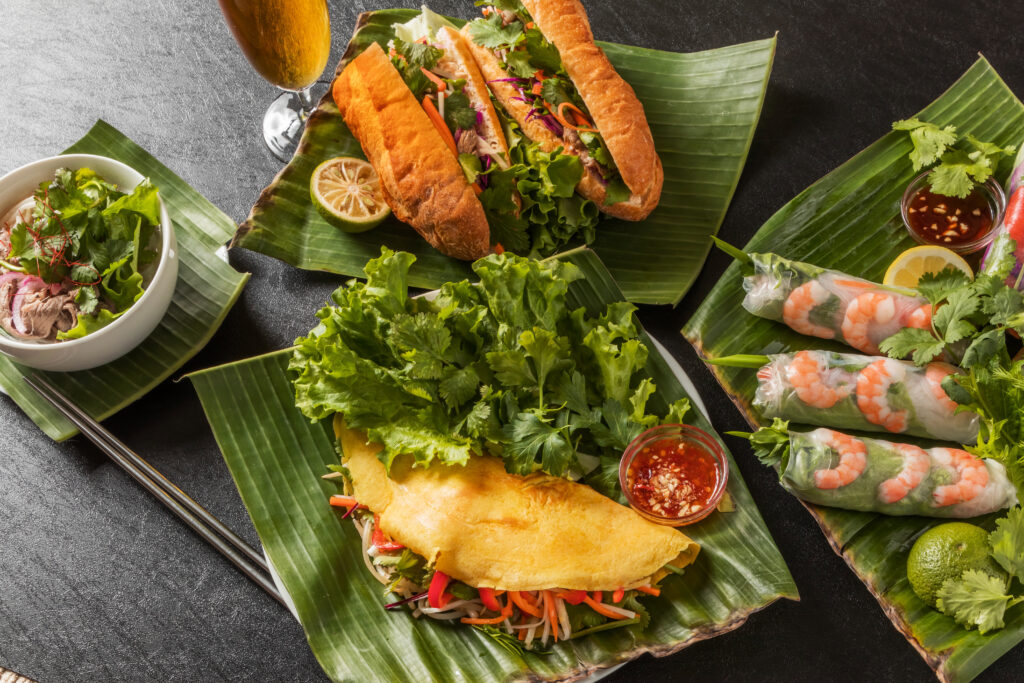
Our food is world-famous for a reason! Vietnamese cuisine is fresh, vibrant, and full of flavor. Whether you’re grabbing a bowl of Pho, savoring a banh mi sandwich, or sampling Ho Chi Minh street food on the Saigon Foodie Night Ride, cycling through Vietnam means you get to taste it all. Every region has its own specialties, so there’s always something new to try.
In Hue, try the rich and spicy bun bo Hue, a beef noodle soup.
In Hoi An, savor the delicate flavors of cao lau, a noodle dish unique to the town.
The Warm Welcome of the Vietnamese People
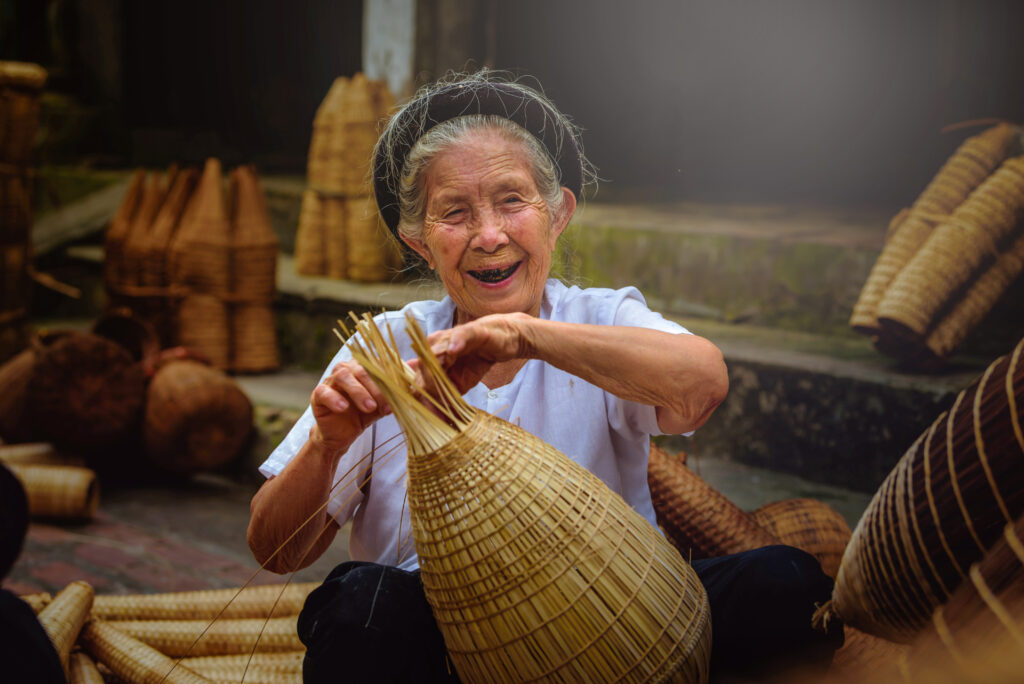
One of the best things about cycling in Vietnam is meeting the Vietnamese people. Wherever you go, you’ll be greeted with waves, smiles, and a genuine sense of hospitality. Our Vietnamese culture is centered around kindness and welcoming visitors, and you’ll feel that warmth every time you stop for a break or pass through a small village.
What to Expect When Cycling in Vietnam?
Cycling in Vietnam
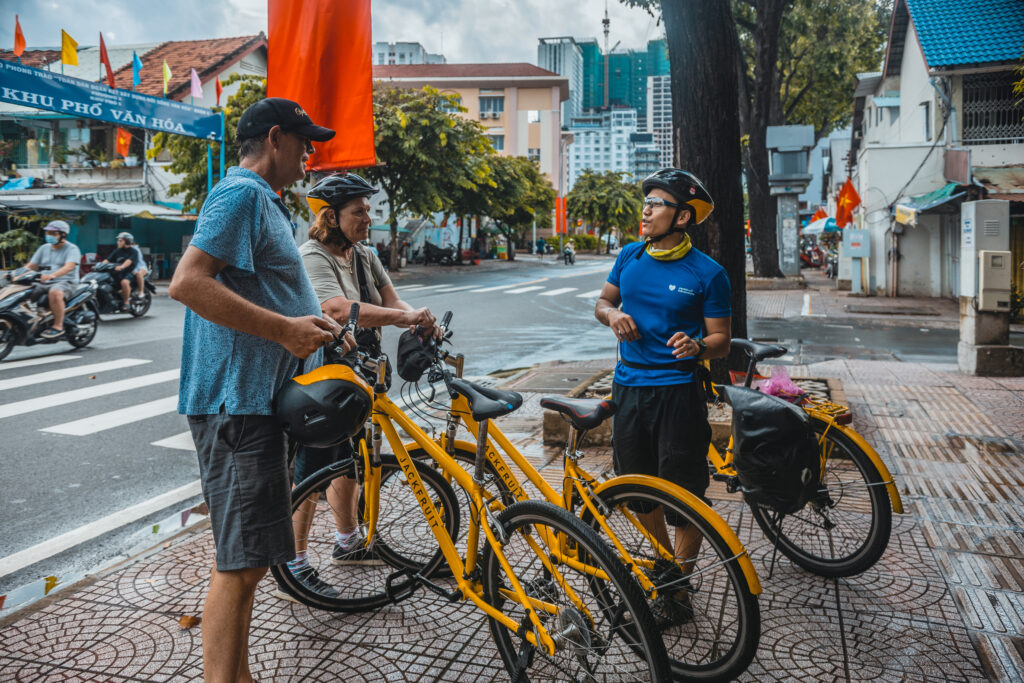
Cycling in Vietnam can be both exhilarating and challenging, depending on the region. Here’s what to expect:
Road Conditions: Roads in Vietnam vary in quality. Major highways between cities are generally in good condition, but you’ll often find narrow, winding roads in rural areas or mountain paths. If you’re heading to regions like Ha Giang or Sapa, expect steep climbs, sharp turns, and gravel paths, which can be tough but rewarding.
Traffic: In big cities like Hanoi and Ho Chi Minh City, traffic can be intense, especially with the thousands of motorbikes zipping around. However, in rural areas or on dedicated cycling paths, it’s peaceful and calm. Just be prepared for busy streets in urban centers and use caution when navigating intersections.
Cycling Gear: Bringing the right gear can make or break your trip. A sturdy touring or mountain bike is ideal for longer journeys, especially if you’re cycling through the mountains or less-developed roads. Make sure to bring:
- A helmet (required for your safety)
- A hydration pack or water bottles (to stay hydrated in the heat)
- Sunglasses and sunscreen (to protect yourself from UV rays)
- A repair kit (for flat tires or minor bike issues)
- Good cycling shoes for extra comfort on long rides
If you prefer not to bring your own bike, Vietnam offers many bike rental shops in tourist areas. You can rent high-quality bikes for a few days or even a few weeks. Make sure to check the bike condition and ask about local repair shops in case you need assistance.
- Safety Tips: Always follow local traffic rules, even if they seem less structured than what you’re used to. Use your bike lights at night, wear reflective gear, and always have a map or GPS handy. Most importantly, take your time—Vietnamese roads are shared by all kinds of vehicles, from ox carts to motorbikes, so keep your eyes open and expect the unexpected.
Cycling Tours in Vietnam: Guided vs. Self-Guided
Cycling in Vietnam
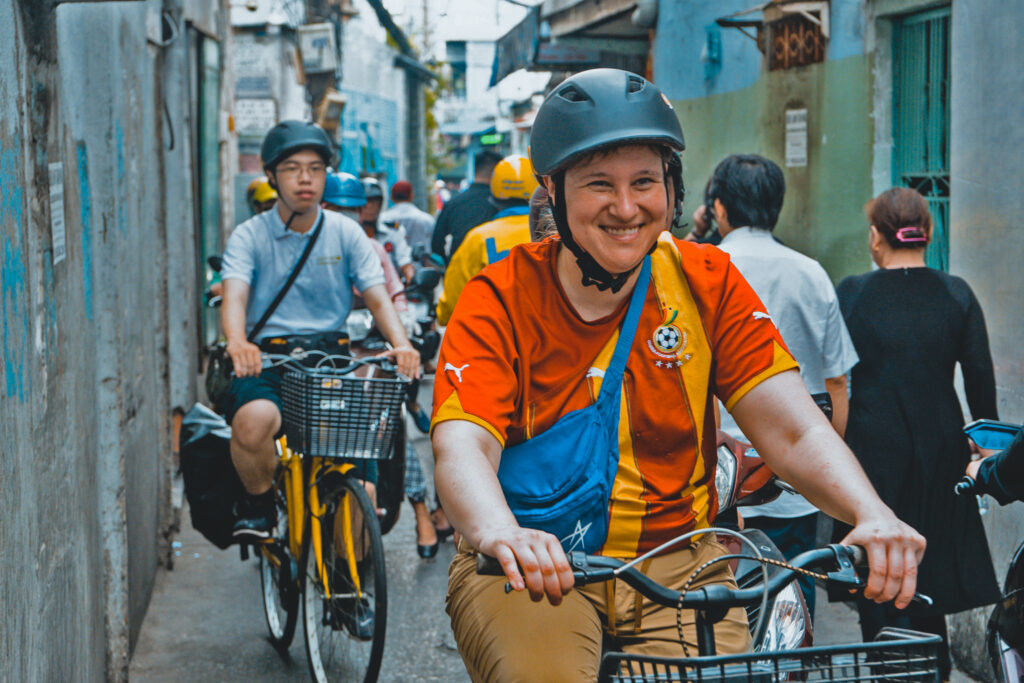
If you’re an adventurous soul who loves to explore independently, Vietnam’s cycling routes are perfect for self-guided tours. However, joining a guided cycling tour can offer a more relaxed experience, as your guide will handle the logistics and take you through the best hidden gems along the way. Both options have their perks:
- Guided Tours: These tours are perfect if you want a worry-free experience. You’ll be part of a small group, and the tour company will provide bikes, meals, accommodation, and even a support vehicle. Guides offer local insights, cultural context, and know the best places to visit. Plus, they’re a safety net if anything goes wrong.
- Self-Guided Tours: More experienced cyclists might enjoy the freedom of a self-guided tour. You can plan your own route, stop whenever you like, and explore at your own pace. Make sure to research well in advance and have a backup plan in case of bad weather or mechanical issues.
Some companies, like Jackfruit Adventure, offer customizable guided tours in Vietnam. We’ll provide support, maps, and recommendations based on your preferences and level of experience.
Where Are the Best Places to Cycle in Vietnam?
Cycling in Vietnam
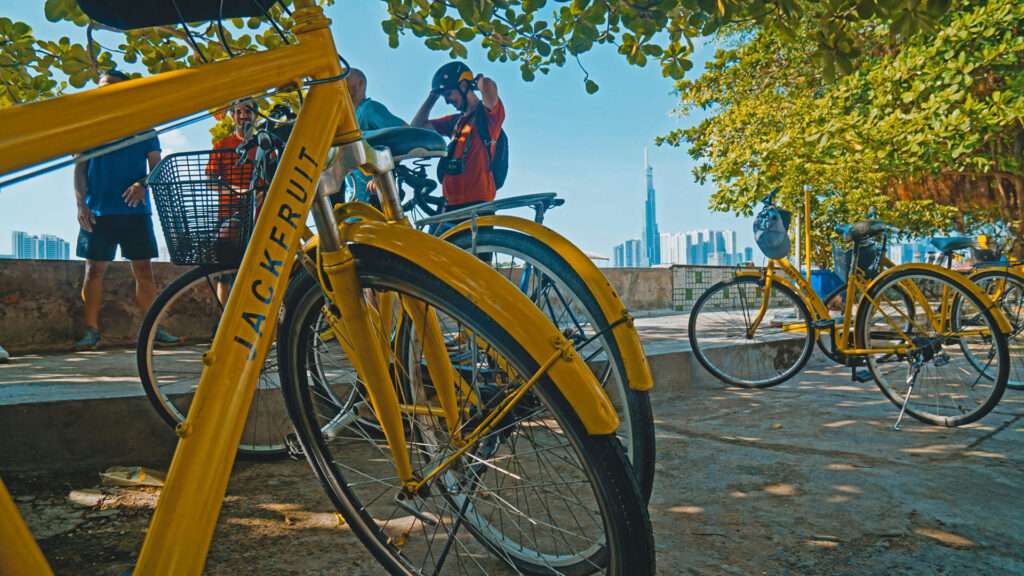
Vietnam offers a wide range of landscapes perfect for cycling enthusiasts. Whether you prefer coastal roads, challenging mountain trails, or cultural adventures, there’s something here for everyone. Let me take you through some of the best cycling destinations in Vietnam:
Hanoi and the Surrounding Areas
Our vibrant capital, Hanoi, is an excellent place to start your cycling adventure. The city itself is rich with history and culture, but as soon as you venture outside, you’ll discover even more beauty in the surrounding regions:
- Ninh Binh — Often called “Halong Bay on Land,” Ninh Binh is a peaceful region with towering limestone karsts, serene rice paddies, and winding rivers. Cycling through Ninh Binh is an unforgettable experience, especially when visiting places like Tam Coc, Trang An, and Bai Dinh Pagoda. Don’t miss the chance to explore the Van Long Nature Reserve, a quiet haven for wildlife enthusiasts.
- Mai Chau — Nestled in the Hoa Binh Province, Mai Chau offers a glimpse of Vietnam’s rural heart. Cycling through lush valleys and friendly ethnic minority communities is a serene way to connect with the quiet beauty of Vietnam’s countryside. Stop by a traditional stilt house for lunch and enjoy the peaceful atmosphere.
Northern Vietnam
Northern Vietnam is famous for its majestic mountain ranges, rich ethnic cultures, and terraced rice fields. If you’re looking for an adventurous cycling journey, the north has plenty to offer:
- Northwest Vietnam (Tay Bac) — The northwest is a cycling paradise! Picture mist-covered mountains, terraced fields, and fast-flowing streams surrounded by wildflowers. The cool highland climate makes it a perfect spot for cycling year-round. One of the highlights is a ride through Mu Cang Chai, where the terraced fields are some of the most beautiful in the world.
- Sapa — Set in the Hoang Lien Son Mountains, Sapa offers stunning views and an opportunity to experience local hill tribe culture. The terraced rice fields are iconic, and the challenging terrain makes for a rewarding adventure. You can also hike or visit local markets, where ethnic minorities sell handmade crafts and textiles.
- The Ha Giang Loop — This remote, mountainous region offers some of the most challenging cycling routes in Vietnam. The Ha Giang Loop takes you through breathtaking scenery and traditional villages, making it an unforgettable experience for experienced cyclists. The winding mountain roads offer spectacular views, especially at the Ma Pi Leng Pass.
Central Vietnam
Central Vietnam’s coastal roads and mountain trails make it a cyclist’s dream. You’ll experience both natural beauty and cultural history along the way:
- Hue to Nha Trang — One of the most scenic routes, this ride takes you from the ancient city of Hue to the coastal town of Nha Trang. Along the way, you’ll pedal through fishing villages, stunning beaches, and the famous Hai Van Pass, known for its panoramic views of the sea and mountains.
- Phong Nha-Ke Bang National Park — This UNESCO World Heritage Site is a must-visit for nature lovers. Cycling through the park’s lush greenery and exploring its caves feels like an adventure straight out of a fairy tale. Don’t miss the chance to explore the Son Doong Cave, the largest cave in the world.
Southern Vietnam
Southern Vietnam offers flat, easy cycling and an abundance of cultural and natural experiences:
- Ho Chi Minh City Cycling — While most visitors flock to the usual historic landmarks, why not go off the beaten path and explore the hidden gems of Ho Chi Minh City with a cycling tour? One of my favorite routes is the escape to Thanh Da Island, a peaceful haven right in the middle of the bustling city! You’ll get to see a different side of Saigon, with its quiet countryside, lush greenery, and tranquil riverside views. It’s the perfect way to balance the energy of the city with a relaxing, scenic ride.
- The Mekong Delta — The Mekong Delta is a region of rivers, swamps, and islands, where you’ll encounter floating markets and lush fruit orchards. The quiet, scenic paths of the Mekong Delta make it perfect for leisurely cycling. Be sure to visit famous floating markets and enjoy fresh tropical fruits along the way.
Hidden Gems: Off-the-Beaten-Path Routes
Beyond the popular cycling routes, Vietnam offers lesser-known trails that take you through untouched landscapes. If you’re looking for a quieter ride away from tourist-heavy areas, consider these hidden gems:
- The Central Highlands: Stretching from Da Lat to Kon Tum, this region is less visited but full of adventure. The cool climate and mountainous terrain are perfect for more advanced cyclists. You’ll ride through pine forests, coffee plantations, and small villages that showcase the highland culture.
- Pu Luong Nature Reserve: Located in Thanh Hoa province, Pu Luong is an off-the-beaten-path destination with scenic cycling routes. Here, you can explore traditional stilt houses, lush rice terraces, and waterfalls. The roads are quiet, and the scenery is a refreshing break from busier tourist spots.
- The Ho Chi Minh Trail: For history buffs, cycling along parts of the famous Ho Chi Minh Trail is a must. This network of paths, once vital during the Vietnam War, is now a peaceful route surrounded by jungle and mountains. For a more urban historical experience, don’t miss the Quach Dam Trail in Chinatown (Cho Lon). This route offers a unique blend of culture and history as you cycle through vibrant streets lined with colonial architecture and traditional markets, giving you a true glimpse of Saigon’s rich past.
Cycling Etiquette in Vietnam
Cycling in Vietnam
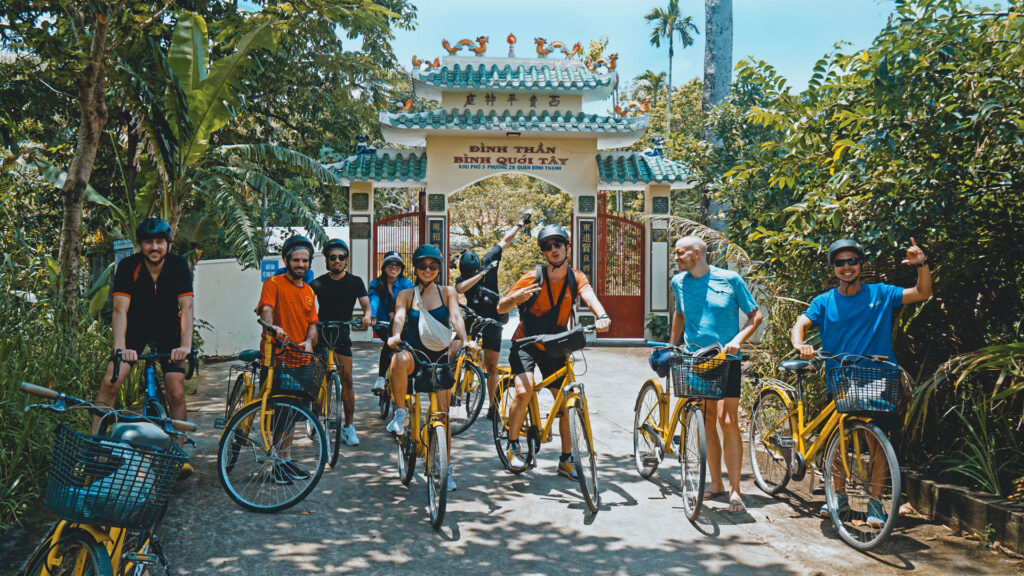
Vietnamese culture is warm and welcoming, and locals are generally happy to interact with foreign cyclists. However, here are a few tips to ensure you’re being respectful as you travel:
- Greet People: Don’t be shy to say hello (“Xin chao!”) as you pass by villagers. It’s a great way to break the ice and connect with locals.
- Ask Before Taking Photos: While people in Vietnam are generally friendly, always ask for permission before taking pictures, especially in rural areas or during cultural ceremonies.
- Respect Sacred Spaces: When cycling near temples, pagodas, or religious sites, be mindful of the rules. Dress modestly and avoid making too much noise.
Cycling Festivals and Events in Vietnam
For cycling enthusiasts, participating in local cycling events can add a fun twist to your trip. Vietnam hosts several cycling races and festivals throughout the year, offering both thrilling competition and a way to explore the country’s diverse landscapes:
Vietnam Victory Challenge
Held in Da Lat, this mountain bike race is one of the most exciting cycling events in the country. It attracts both professional and amateur cyclists from around the world, taking them through challenging terrains in the central highlands. The event spans several days, with different stages focusing on endurance, skill, and navigating rough trails.
Mekong Delta Cycling Tournament
This multi-day race covers long distances, taking participants through the lush landscapes of the Mekong Delta. Cyclists pass through rural villages, rice paddies, and along scenic waterways, offering an immersive experience in Vietnam’s southern countryside. It’s a great way to experience the region in a competitive setting.
Ho Chi Minh City TV Cup
One of the largest and most prestigious cycling events in Vietnam, the Ho Chi Minh City TV Cup is held annually in celebration of Vietnam’s Reunification Day on April 30th. It’s a multi-stage race that takes cyclists across hundreds of kilometers, from north to south, culminating in the bustling streets of Ho Chi Minh City.
Coupe de Hue
The Coupe de Hue is an international road cycling race held in the historical city of Hue. The event combines cultural sightseeing with athletic challenges, as participants ride through historic landmarks, including the ancient Imperial Citadel. With a mix of professional and amateur cyclists, this race offers multiple categories, from short sprints to long endurance races.
VTV International Cycling Tournament
Organized by Vietnam Television (VTV), this international cycling race is an annual event that attracts top cyclists from across Asia and beyond. The race features multiple stages that cover various provinces across the country, showcasing Vietnam’s coastal roads, mountainous regions, and vibrant cities.
Vietnam Mountain Marathon
While primarily a trail running event, the Vietnam Mountain Marathon in Sapa includes mountain biking options for participants who prefer to cycle through the stunning landscapes of the Hoang Lien Son mountain range. The trails offer challenging climbs and breathtaking views, making it a must for adventure seekers.
What are the Best Cycling Routes in Vietnam?
Vietnam has a cycling route for everyone, no matter your skill level or preferences! From stunning coastal roads to peaceful countryside paths, there’s something for every cyclist here. Let me share with you some of the most popular and unforgettable routes that will let you experience the best of Vietnam:
Ho Chi Minh City to Hanoi Cycling
This is the classic cycling journey—an epic route that covers around 1,700 kilometers, taking you from the bustling streets of Ho Chi Minh City in the south, all the way to the historic capital of Hanoi in the north. Along the way, you’ll pass through charming towns, beautiful coastal stretches, and peaceful rural areas. You’ll ride through Vietnam’s diverse landscapes, from lush rice paddies to hills and tropical rainforests. It’s truly a journey that lets you experience Vietnam up close and personal! And as you near Hanoi, don’t miss the chance to visit Ha Long Bay, one of the most iconic spots in the country and a UNESCO World Heritage Site.
- Northern Vietnam offers more hilly and challenging routes, while Southern Vietnam around Saigon is flatter and perfect for more relaxed cycling.
Coastal Vietnam Cycling
Cycling along Vietnam’s coastline is a dream come true! Starting in the ancient city of Hue, this route takes you through fishing villages, peaceful beaches, and one of Vietnam’s most famous mountain passes—the Hai Van Pass. The views from up there are absolutely breathtaking! As you ride, don’t forget to explore Hoi An, with its lantern-lit streets and UNESCO World Heritage-listed Old Town. The combination of ocean views, cultural treasures, and local experiences makes this route one of the most magical in Vietnam.
High in the Northwest Mountains
For those looking for a real adventure, this mountainous route in northern Vietnam is a must-try. Starting and ending in Hanoi, it’s a cyclist’s favorite, as it takes you through some of the most stunning scenery in the country. Imagine riding through terraced rice fields, with the mist-covered mountains rising around you. Along the way, you’ll meet ethnic minority communities and get a taste of their rich traditions and culture. And don’t miss Sapa, nestled in the Hoang Lien Son Mountains, where the views are out of this world and the local hill tribe culture will leave a lasting impression.
Mekong Delta Cycling
The Mekong Delta is known as Vietnam’s “rice bowl,” and cycling through this lush, water-filled region is a peaceful and scenic experience. Here, life moves a little slower. You’ll pass floating markets, green rice paddies, and canals that wind through the countryside. The Mekong Delta also offers the chance to hop on a boat and explore the maze of waterways up close, while tasting some of the region’s delicious, fresh cuisine. It’s a perfect way to see the heart of southern Vietnam’s countryside life.
When is the Best Time to Cycle in Vietnam?
Picking the right time to cycle in Vietnam is key to having a great experience. With our tropical climate, Vietnam has hot summers, mild winters, and a pretty intense rainy season. To help you plan your trip, here’s a breakdown of the best times in Vietnam to hit the road, depending on where you’re going:
Northern Vietnam
Northern Vietnam, which includes places like Hanoi, Sapa, and Ninh Binh, has four distinct seasons:
- Spring (March to April): In spring, northern Vietnam is simply stunning. The weather is mild, flowers are in bloom, and it’s the perfect time to cycle through colorful, lively landscapes. The pleasant temperatures make for comfortable rides.
- Summer (May to August): Summer here can get hot and humid, with the occasional rain shower. While it can be more challenging to cycle in the heat, with proper preparation, you can still enjoy your ride. Just be sure to stay hydrated and pace yourself.
- Autumn (September to November): This is one of the best times to go cycling in northern Vietnam! The cool, dry weather is ideal for long rides, and the countryside looks magical with clear skies and colorful leaves. It’s a fantastic time to explore the northern landscapes.
- Winter (December to February): Winter can get chilly, especially in mountainous areas like Sapa, but it’s still a good time to cycle if you’re prepared with warm clothing. It might be colder, but the scenic beauty of the region makes it worthwhile.
In short: The ideal time for cycling in northern Vietnam, especially in the mountains, is from late August to May. December and January can get cold and a bit rainy, so come prepared!
Halong Bay
Located in northeastern Vietnam, Halong Bay has its own weather patterns because of its coastal location. Here’s what you can expect throughout the year:
- Spring (March to April): Spring is a lovely time to visit Halong Bay. The temperatures are mild, ranging from 20°C (68°F) to 25°C (77°F), making it a great time for cycling. However, occasional rain showers can pop up, so it’s always a good idea to carry rain gear and check the forecast.
- Summer (May to August): Summer brings higher temperatures and humidity, with July and August being the hottest months. You’ll want to wear light, breathable clothing and stay hydrated. This is also the rainy season, so be prepared for sudden rain showers and thunderstorms.
- Autumn (September to November): Just like the north, autumn is considered the best time to visit Halong Bay. With temperatures between 20°C (68°F) and 28°C (82°F), the weather is mild, and there’s less rain, making it perfect for cycling while soaking up the stunning views.
- Winter (December to February): Winter is cooler, with temperatures ranging from 15°C (59°F) to 20°C (68°F). It’s still possible to cycle, but be prepared for fog and chilly mornings, especially if you’re planning an early ride. Dress warmly and check for foggy conditions that might affect visibility.
In short: The ideal time to cycle in Halong Bay is from October to May. Summer brings more rain, while December and January can get a bit chilly and foggy. For fewer crowds and great weather, autumn is your best bet.
Central Vietnam
Central Vietnam, a beautiful coastal stretch, has a unique climate with two main seasons:
- Dry Season (February to August): The dry season is fantastic for cycling along the coast. Expect sunny skies and hot weather, especially from May onwards. Exploring the beaches and enjoying coastal rides during this time is an absolute joy. Just make sure to start your rides early or late in the day to avoid the hottest part.
- Rainy Season (September to January): During the rainy season, central Vietnam sees frequent showers and even occasional typhoons. This can make cycling tricky due to heavy rain and potential road disruptions, so keep an eye on the weather forecast and plan accordingly.
In short: The best time to cycle in central Vietnam is from January to early September. Temperatures hover around 30°C, making it ideal for enjoying the stunning coastal views.
Southern Vietnam
Southern Vietnam, including Ho Chi Minh City and the Mekong Delta, has a tropical climate with two distinct seasons:
- Dry Season (December to April): This is the perfect time to explore southern Vietnam on a bike. The weather is cooler and dry, making long rides much more comfortable. Keep in mind that it can still get quite hot, especially in March and April, but the sunny skies and pleasant breezes make up for it.
- Rainy Season (May to November): During the rainy season, the humidity rises, and the rain can come on suddenly. But don’t let that stop you! Cycling is still possible, and the countryside is lush and vibrant at this time. Just be ready for wet roads and quick rain showers.
In short: Southern Vietnam is great for cycling year-round, with temperatures around 30°C most of the year. While April and May can be hot, the rest of the year is perfect for cycling. November to February is the best time for cycling, with clear skies and a gentle ocean breeze.
Enjoying Vietnamese Cuisine
Cycling in Vietnam
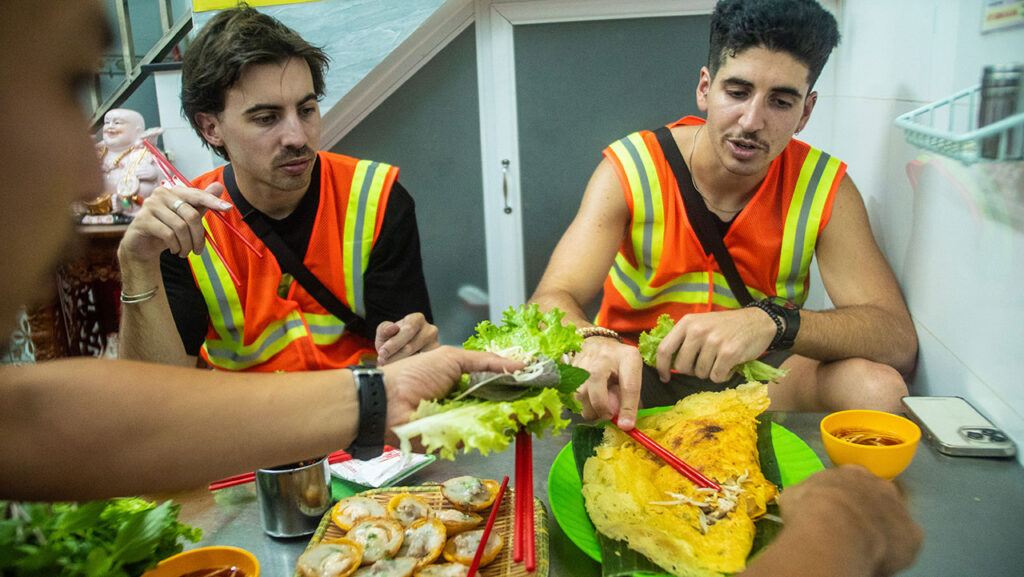
One of the best parts about cycling in Vietnam is the food! Vietnamese cuisine is all about fresh ingredients, vibrant flavors, and that perfect balance of tastes. Whether you’re on a daytime ride or enjoying Saigon Foodie Night Ride, you’ll have the chance to indulge in some of the country’s most iconic dishes. Here are a few you won’t want to miss:
Pho — Vietnam’s most famous dish, pho, is a fragrant noodle soup that’s perfect after a long day of cycling. Whether it’s made with beef or chicken, it’s always served with fresh herbs and condiments on the side. There’s nothing quite like grabbing a bowl of pho on the streets of Saigon, especially if you’re winding down after a ride.
Banh Mi — This Vietnamese sandwich is a delicious fusion of French and local influences. The crispy baguette is stuffed with a variety of fillings, like grilled meats, pâté, pickled veggies, and fresh herbs.
Bun Cha — A must-try in Hanoi, bun cha is a dish of grilled pork served with rice noodles, fresh herbs, and a tangy dipping sauce. If your cycling adventure takes you up north, make sure to stop for a plate of this classic dish!
Banh Xeo — These crispy, savory pancakes are made with rice flour and stuffed with shrimp, pork, bean sprouts, and herbs. The best way to eat them? Wrap them in lettuce leaves, dip them in a tangy sauce, and enjoy!
Ca Phe — Don’t forget to try Vietnamese coffee! Whether you prefer a cup of ca phe sua da (iced coffee with condensed milk) or the unique ca phe trung (egg coffee), it’s a must for any coffee lover. It’s the perfect pick-me-up during your cycling journey through the vibrant streets of Saigon, and we know just the right places to stop and enjoy it on our food tours.
Vietnam Visa Requirements
Cycling in Vietnam
If you’re planning to visit Vietnam for a cycling adventure, you’ll need to check the visa requirements for your country. Luckily, residents from several countries are exempt from needing a visa for short tourist visits. To see if your country qualifies for visa exemption, it’s best to check the latest list on the Vietnam Foreign Affairs website.
E-Visa
The e-visa process is a newer and easier option for many travelers. It’s quick, straightforward, and can be done entirely online! You just apply through the official government website, and once it’s approved, print it out and bring it with you when you arrive in Vietnam. One of the great things about the e-visa is that it’s not limited to just airports—you can use it at land borders too. Processing times usually range from 2 to 7 working days, but we suggest applying at least 2 weeks in advance just to be safe. You can read more about the tourist e-visa process and apply on the Vietnam Immigration portal.
Here’s what you’ll need to apply:
- Passport Scanned Copy: Make sure to upload a scanned copy of your passport’s main page (not a mobile or laptop photo—just use a proper scanner for best results).
- Passport-Size Photo: A standard visa photo (4×6 cm, color, white background, no glasses). While it’s tempting to take one on your phone or laptop, I recommend getting it done at a local photo studio to avoid any issues.
For more details on the visa process, this resource on Vietnam visas is also worth checking out.
Vaccines and Medicines
Cycling in Vietnam
While there aren’t any mandatory vaccinations required by Vietnamese law for most travelers (except for yellow fever in some cases), it’s still a good idea to check in with your medical provider before your trip. They can offer personalized advice based on your health history and which vaccines you may already have. This way, you’ll feel extra prepared and can enjoy your cycling adventure in Vietnam with peace of mind!
Most of our travelers don’t need any special vaccinations before visiting Vietnam, and we don’t have any specific vaccines to recommend. However, it’s always better to consult a healthcare professional to see what’s best for you.
If you’d like more detailed information, here’s a great resource for recommended vaccinations for Vietnam that’s worth checking out.
Handy Info
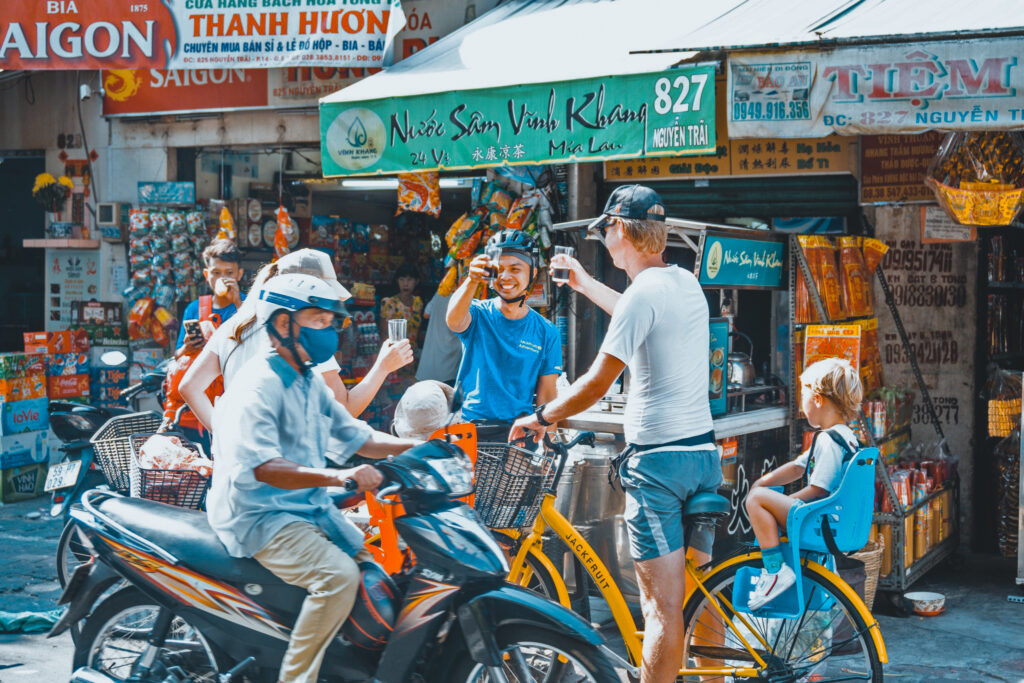
Here are a few things that will come in handy during your cycling adventure in Vietnam:
- Currency — Our official currency is the Vietnamese Dong (VND). As of September 2024, 1 US Dollar equals about 24,645 Dong. In larger cities like Hanoi and Saigon, some places may accept US dollars, but for smaller shops, towns, and rural areas, it’s best to have Vietnamese Dong on hand. Most ATMs only dispense Dong, so you’ll want to make sure you’re stocked up. While Mastercard and Visa are widely accepted in larger businesses, it’s a good idea to always keep some local currency on you for smaller purchases.
Hint: Check out “Best places to exchange money in Hanoi” to obtain the best exchange rates
- Transport — Getting around in Vietnamese cities is easy with plenty of options like motorbikes, bicycles, taxis, and ride-hailing apps like Grab or Xanh Sm. If you’re traveling between cities, there’s a solid network of buses, trains, and domestic flights connecting major destinations like Saigon and Hanoi.
- Language — Vietnamese, or “Tieng Viet,” is our official language, but you’ll find that English is widely spoken, especially in tourist areas. You might also hear some French, a reminder of Vietnam’s colonial past. While many locals speak English, learning a few Vietnamese phrases can always make your experience more enjoyable!
- Culture — Vietnam is a country full of warm, friendly people who appreciate politeness and respect for traditions. While many people identify as atheists, Buddhism, Christianity, and folk religions are practiced by some. Remember to dress modestly when visiting sacred places or people’s homes, and don’t forget to remove your shoes before entering. It’s polite to ask for permission before taking photos of people, and it’s best to avoid photographing military areas.
- Appliances & Devices — Vietnam’s electricity runs at 220V and 50 Hz. If you’re coming from North America or Japan (where voltage is lower), you’ll want to check if your devices are compatible. We mostly use two-pin plugs (Types A, C, and F), so if your devices have a 3-pin plug, be sure to bring an adapter.
- Mobile Coverage — Vietnam has excellent mobile coverage in most areas, though you might find some spots lacking in the remote mountains. If you’ve activated global roaming, your phone should work fine, but getting a local SIM card from Viettel, MobiFone, or Vinaphone is a great option for longer stays. Mobile internet is cheap and reliable, making it easy to stay connected during your trip.
- Cuisine — Vietnamese food is a highlight of any trip! We use a lot of rice, soy, fish, and pork, and peanut sauce is common in many street foods. If you have any allergies, it’s a good idea to let your guide know in advance. Be sure to try our famous green tea, which is enjoyed all over the country. Vietnamese cuisine is diverse and delicious—there’s something for everyone to enjoy!
- Religion — Though Vietnam is officially an atheist state, you’ll find many people practicing Buddhism or Christianity. Our religious diversity is a big part of our cultural richness.
- Time Zone — Vietnam operates on GMT+7, so make sure to adjust your watches accordingly!
Embrace the Cycling Tour in Vietnam
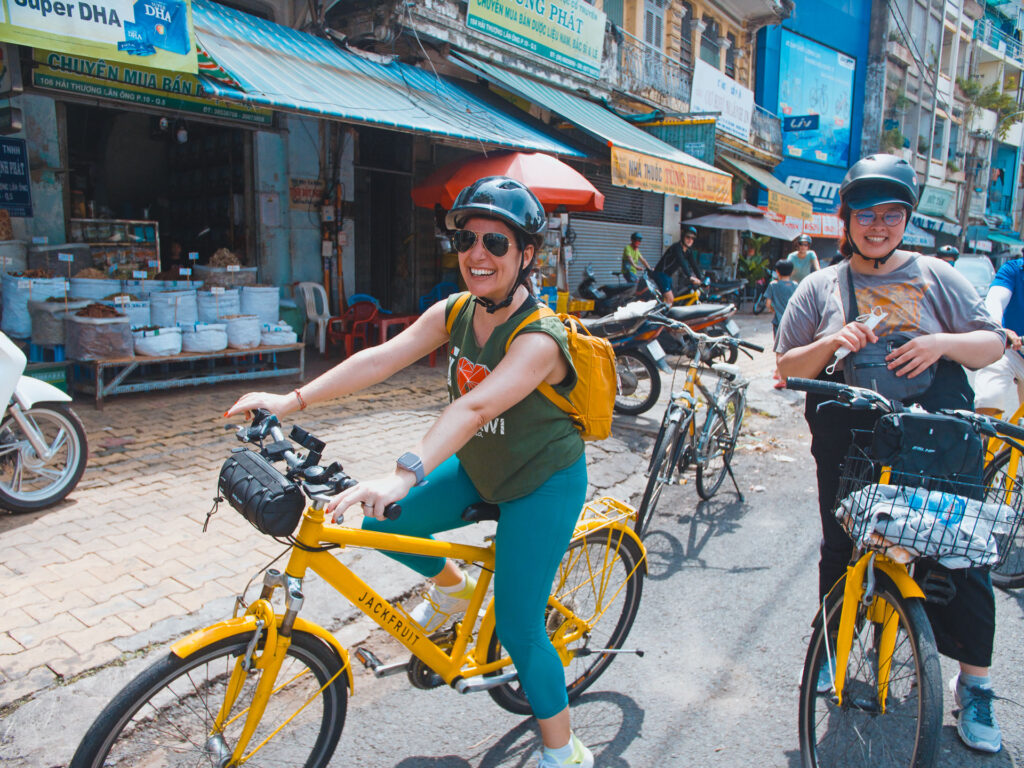
Cycling in Vietnam is more than just an adventure—it’s an experience that lets you connect deeply with the culture, people, and natural beauty of this vibrant country. Whether you’re gliding past rice paddies, pedaling through busy streets, or tackling mountain trails, every ride in Vietnam is filled with discovery.
Make sure to book Jackfruit Adventure, where cycling tours are combined with local food experiences, giving you a deeper dive into Vietnam’s heart and soul. Whether you opt for a guided group or plan a self-guided tour, the memories of cycling in Vietnam will stay with you for years to come.
With these extra details, your guide is now more comprehensive and provides even more value for cycling enthusiasts planning their Vietnam adventure. Let me know if you’d like any further adjustments!
Ho Chi Minh City Cycling Tour In Ho Chi Minh City (Saigon) – Vietnam
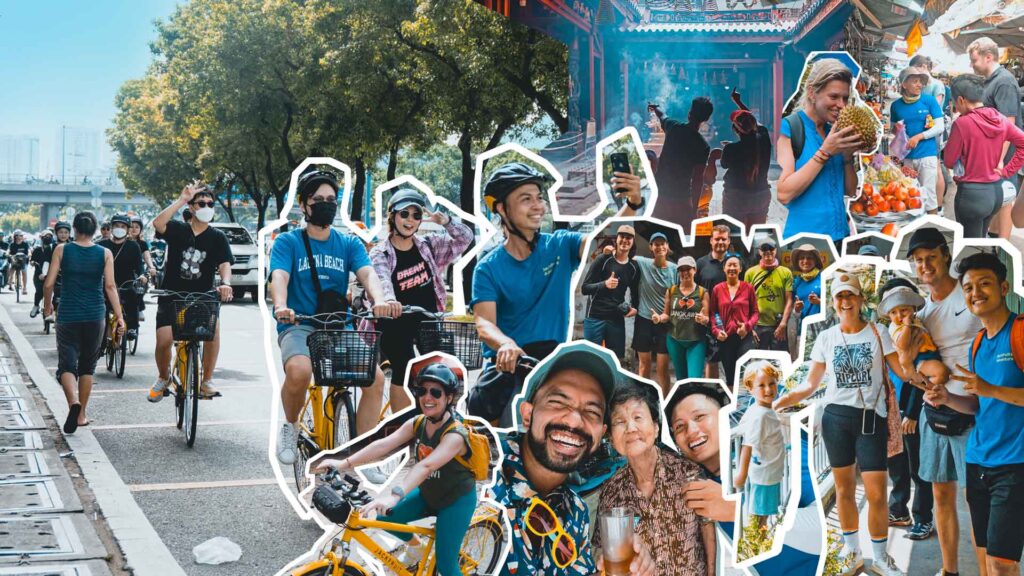
At Jackfruit Adventure, we organize Ho Chi Minh City Cycling Tour and Team Building Ho Chi Minh. With a deep knowledge of Saigon city and local connections, we believe we can give you an awesome bonding time together. Contact us today if you have any requests or questions to prepare a trip for your team to bond in Ho Chi Minh – Vietnam.


